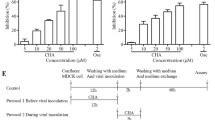Summary
The activity of nano carbon fullerene lipidosome (NCFL) against influenza virus H1N1 in vitro was studied by observing the cytotoxicities and its activity rendered by different intensities of lighting with various periods of time. Rimantadine hydrochloride was used as the positive control drug. By using microcultural technique, the morphological changes of cells were observed and by using the gentian violet staining, antiviral activity of the NCFL against influenza virus was assayed. The results showed that: (1) The maximal concentration of the NCFL was 7 μg/mL and the 50% toxic concentration (TC50) was 13.54 μg/mL respectively; (2) NCFL had a significant activity of directly killing the influenza virus, while the activities in antiadsorption and antireplication were not obvious; (3) There was a dose-activity relationship between the dosages of NCFL and the direct killing effect against the influenza virus, and the periods of lighting-time could influence the activity partly. It was concluded that NCFL had a significant activity of directly killing the influenza virus.
Similar content being viewed by others
References
Dong Z Z, Yao D F. Research advancement of influenza virus pathogenic mechanism. Mod Med Sci (Chinese), 2003,19(4):406–408
Kroto H W, Henth J R, Obrien S C et al. The structure and properties of fullerenes. Nature, 1985,318:162
Friedman S H, DeCamp D L, Sijbesma R P et al. Inhibition of the HIV-1 protease by fullerene derivatives: model building studies and experimental verification. J Am Chem Soc, 1993, 115(15):6506–6509
Tokuyama H, Yamago S, Nakamura E et al. Photoinduced biochemical activity of fullerene carboxylie acid. J Am Chem Soc, 1993,115:7918–7919
Huang Z X. Medical Virology Foundation and Experimental Technology (Chinese). Beijing: Science Publishing Company, 1990.
Zarubaev V, Anfimov M, Rylkov V et al. Photodynamic inactivation of influenza virus with fullerene suspensions in allantoic fluid. Photodiagn Photodyn Ther, 2007,4(1):31–35.
Arbogast J W, Darmany H P, Foote C S et al. Photophysical properties of C60. J Phys Chem, 1991,95(1):11–12
Cheng F Y, Yang X L, Zhu H S et al. Synthesis of oligoadducts of malonic acid C60 and their scavenging effects on hydroxyl radical. J Phys Chem Solid, 2000,61:1145–1148
Author information
Authors and Affiliations
Additional information
This project was supported by a grant from National Natural Sciences Foundation of China (No. 30370069).
Rights and permissions
About this article
Cite this article
Ji, H., Yang, Z., Jiang, W. et al. Antiviral activity of nano carbon fullerene lipidosome against influenza virus in vitro . J. Huazhong Univ. Sci. Technol. [Med. Sci.] 28, 243–246 (2008). https://doi.org/10.1007/s11596-008-0303-6
Received:
Published:
Issue Date:
DOI: https://doi.org/10.1007/s11596-008-0303-6




